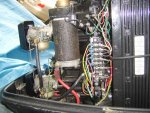maxum247
Lieutenant
- Joined
- Sep 18, 2007
- Messages
- 1,363
How do I check for a good rectifier? Book said to set ohm meter to x1 ohm position. My meter has RX1K on it. It will read fine, but my question is will I get the right results set at RX1K is this the same reading as X1? I get good readings on both rectifiers that I have this way. All readings were around 1.5 on each unit. I did my test according to the manual I have. Next question that I have is when I go neg to pos on each I get a reading of 4 on both rectifiers, I know this was not part of the recommended test, but would it give a sign of good or bad. Battery doesn't charge on either one now. Fried a battery and the new one stopped charging or at least I think it did. Battery drains down after about 6 trips and it is started a lot in those 6 trips. Guess my true question is am I going about the test the right way or are the readings I'm getting not as good as I think?
I did AC to +, neg to AC on each of the four poles.
I realized as soon as I clicked the button that this post was in the wrong area.
I did AC to +, neg to AC on each of the four poles.
I realized as soon as I clicked the button that this post was in the wrong area.





















